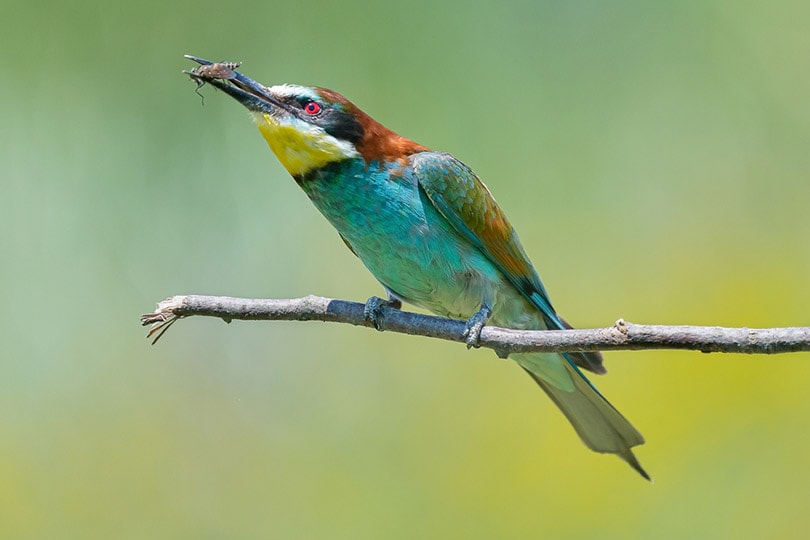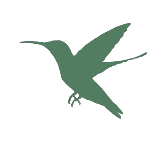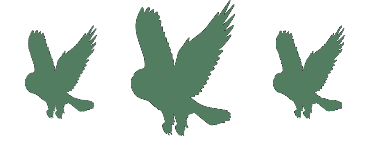Do Birds Eat Wasps? What You Need to Know!
Last Updated on

Of all the insects crawling, slithering, and buzzing around, few fill people with fear more than wasps1. Because these omnivorous insects produce a painful sting, many people want to rid their outdoor living spaces of wasps by using repellents and traps. You may be surprised to learn that many species of birds eat wasps. Some bird species regularly dine on them, while others eat them occasionally as snacks.
Like all insects, wasps have many predators, including larger insects, amphibians, reptiles, and birds. Even though they produce a painful sting, wasps are rich in protein, which is something birds need in their diet2.

Birds That Routinely Eat Wasps
Many bird species eat wasps, including the following:
- Starlings and Magpies: Starlings and magpies eat many types of insects including wasps, bees, flies, butterflies, caterpillars, and beetles.
- Sparrows and Chickadees: Even though they’re petite, sparrows go after wasps by following them until they land, quickly snatching them, and gulping them down without even using their talons.
- Chickadees are another small bird species that aren’t afraid to snatch wasps from the air and nests. These quick, little birds are adept at eating wasps and other stinging insects, like honeybees.
- Blue Jays: The fearless and aggressive Blue Jay mostly eats plants and nuts, but they will go after wasps when they’re hungry.
- Woodpeckers: With their long tongues, woodpeckers can easily swoop into a wasp nest and snatch the insects and their larvae to make a quick meal. Woodpeckers prefer protein-rich wasps over many other insects, which isn’t surprising considering they’re well-equipped to deal with wasps.
- Warblers: Even though warblers are small, these birds can easily catch wasps, honey bees, and flying insects using their beaks.
- Bluebirds: Bluebirds are often found in backyards and parks. These pretty birds routinely catch wasps buzzing around their territory for a quick meal. Bluebirds also feast on flies, spiders, caterpillars, and beetles.
- Catbirds: Like woodpeckers, catbirds have long tongues they use to eat wasps. Catbirds routinely go after wasps to provide them with ample protein for long-term survival.
- Northern Cardinals: Northern Cardinals are medium-sized birds that will feed on various insects, including wasps and honeybees they find under the leaves and flowers of trees.
This is not an exhaustive list of birds that eat wasps because most birds eat a varied diet consisting of many types of insects. It does, however, give you a good idea of what types of birds eat wasps.
If you have some of these common birds in your backyard, keep an eye out to see if you can catch them snatching up and eating wasps—it’s quite a sight to see!

Birds Are Not Impervious to Wasp Stings
You may be wondering whether birds get stung by wasps and if they’re affected by wasp venom. Like humans, birds can get stung by wasps and feel pain from the venom injected by these flying insects. This is why most birds prey on solitary wasps like the mud dauber.
Solitary wasps are more docile and rarely sting compared to social wasps. Solitary wasps also rarely defend their nests, so birds can easily swoop in and enjoy some tasty wasp larvae before flying away. As you can see, birds are picky when it comes to the types of wasps they eat. After all, birds don’t like being stung any more than we do.
How to Attract Birds to Your Yard
If you’d like to enjoy watching wild birds, put up a bird feeder and fill it with wild bird food that attracts species living in your area. If you’re unsure of the types of birds you have around you, ask your neighbors or do some online research to find out.
When placing a bird feeder in your yard, put it where birds will feel safe from predators, including neighborhood cats. A well-placed bird feeder will be several feet off the ground and away from brush piles, evergreen trees, and bushes.
Once you get your feeder set up and fill it with food, it’s only a matter of time before the birds will come to feast. Get your camera ready so you can snap some quick shots of your feathered friends coming and going as they feast on the food you’ve put out.


In Conclusion
Many types of wild birds eat wasps without getting stung. Most birds are very skilled at eating all sorts of stinging insects, such as wasps, honey bees, and hornets that we humans typically shy away from.
Bird watching is a fun hobby, so consider placing a feeder in your yard to watch wild birds in action. If you’re lucky, you’ll watch in amazement as a bird snatches a passing wasp right out of the air to make a quick meal of it.
Featured Image Credit: Piotr Poznan, Shutterstock
About the Author Robert Sparks
Robert’s obsession with all things optical started early in life, when his optician father would bring home prototypes for Robert to play with. Nowadays, Robert is dedicated to helping others find the right optics for their needs. His hobbies include astronomy, astrophysics, and model building. Originally from Newark, NJ, he resides in Santa Fe, New Mexico, where the nighttime skies are filled with glittering stars.
Related Articles:
What Is the Best Binocular Magnification for Hunting? Optical Features Explained
10 Types of Hummingbirds in Arkansas (With Pictures)
8 Types of Hummingbirds in Nebraska (With Pictures)
5 Types of Hummingbirds in Idaho (With Pictures)
3 Types of Hummingbirds in Mississippi (With Pictures)
8 Types of Hummingbirds in Kansas (With Pictures)
5 Types of Hummingbirds in West Virginia (With Pictures)
5 Types of Hummingbirds in Ohio (With Pictures)
